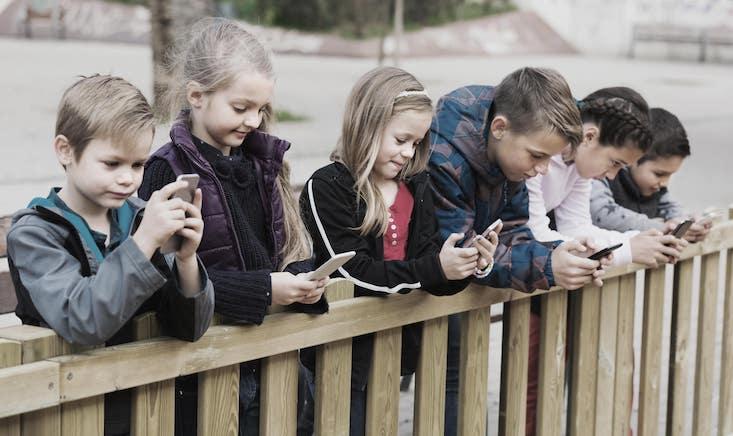
It looks like grownups can disregard the fear-mongering about the ill effects of digital media on kids. A 2017 study in Child Development found “little or no support for harmful links between digital screen use and young people’s psychological well-being.” Parents can police their kids’ smartphone use if they like, but they should know such restrictions aren’t evidence-based. As authors Andrew Przybylski and Netta Weinstein explain, “a critical cost-benefit analysis is needed to determine whether setting firm limits constitutes a judicious use of caregiver and professional resources.”
The American Academy of Pediatrics currently recommends that parents limit screen time to less than two hours for children two to five years old. But when researchers compared those who implemented these limits with those who didn’t, they found no significant difference in the level of children’s well-being. Apparently, the guidelines hadn’t been empirically evaluated before; they were based on findings which show that media use can supplant other activities, potentially leading to sedentary behaviors and/or loss of sleep.
There has never been conclusive evidence that screens are a direct cause of harm. But couple correlation with the fear of change, and that’s reason enough, apparently, for grownups to treat digital devices as suspect. It turns out, the prejudice wasn’t warranted.
Human beings always mediate their experiences through tools.
Przybylski and Weinstein’s study—based on data collected from a representative sample of 19,957 parents who reported on their children’s levels of attachment, resilience (or bouncing back quickly from adversity), curiosity, and positive affect—found that young people who engaged in less than the AAP’s recommended limits showed “slightly higher levels of resilience but lower levels of positive affect compared to those who did not.” These differences became insignificant once the authors considered contextual factors like ethnicity, household income, and caregiver’s education level. Surprisingly, they also found “extremely small positive effects” that correlated with digital engagement at a level much higher (“up to 7/hr for both television and computer-based media”) than what’s commonly considered healthy.
That’s not all: A new study in Nature Human Behaviour, which looked at data from more than 350,000 adolescents, also found that digital tech use mattered little to kids’ well-being. The authors, Amy Orben and Przybylski, argue that prior research, which examined the impact of social media on teens and tweens, was based on weak correlations and insufficiently comprehensive methods, and therefore drew false conclusions. When they analyzed the same data, they found that “the association of well-being with regularly eating potatoes was nearly as negative as the association with technology use, and wearing glasses was more negatively associated with well-being.” To put a number on it: Digital tech use explains about 0.4 percent of the variation in well-being, the researchers write. “Taking the broader context of the data into account suggests that these effects are too small to warrant policy change.”
These results don’t suggest we should stop thinking about how to best raise kids to thrive in a connected world. Instead, it suggests we find a different, more useful way of discussing screen media. People usually talk about kids and technology from a medical perspective. We ask: Is it healthy or unhealthy? Even psychologists tend to use a diagnostic approach: Does social media exposure lead to anxiety or depression? Narcissism? Loneliness? Feelings of isolation?
These sorts of questions tend to leave out the crucial fact that human beings always mediate their experiences through tools. In fact, toolmaking may have played a pivotal role in humanity’s cognitive development. I suspect a more optimistic story about the place of digital devices in our lives would better serve our children: Consider that we use trendy technological metaphors to describe human nature—you’re hardwired for social connection; the adolescent brain is programmed to take risks. The tools of the times, in other words, always provide the symbolic foundation for representing and understanding the human self. We urgently need to iterate the old theories of child rearing, making sure the essential values and principles—compassion, kindness, respect, integrity—remain relevant, even as the economic and technological trends change.
We might borrow from preeminent thinkers like G. Stanley Hall and Jean Piaget, who both integrated epistemology, sociology, and moral philosophy into their understandings of child development. Their messages about the social, cultural, and civic benefits of child’s play, which now hide beneath a century’s worth of research, are worth resurfacing. What’s more, we can transfer what scientists now know about playgrounds to the digital sandbox. Play enhances attention inhibition, cognitive flexibility, executive function, self-regulation, and more. And while there’s still not adequate research to draw evidence-based conclusions about whether all the same benefits come from digital play, it seems unlikely that the presence of new toys would suddenly render play harmful—especially when you consider that the sandbox, the sliding board, and the teddy bear were all new toys during the industrial era.
Similarly, we can borrow from Object-Relations theorists like D.W. Winnicott. He gave us a structural model of the adolescent process of reality acceptance. He described how maturation involves learning to reconcile our internal experiences with external feedback that often feels dissonant or divergent. He explained how playful experiences in “transitional spaces” enable teens and tweens to cope with the recognition that grownup authority figures are fallible—and yet these same adults continue to be our primary role-models, icons of adulthood that contour and trigger feelings of guilt, shame, regret, pride, aspiration, and more. Could it be that Instagram, Snapchat, Twitter and TikTok play the same role in social development that sock-hops, soda shops, and 7-Eleven parking lots once did? Perhaps. But we won’t know until we try to apply Winnicott’s findings to the social media landscape.
Ultimately, what matters most is that we provide our children with a sense of agency and autonomy by teaching them that tools don’t use us, we use them. Parents should stop worrying that there’s something fundamentally wrong with screen time. Sure, kids can develop unhealthy relationships with their devices, and when they do, intervention is appropriate. But when the grownups imagine digital technology as an evil temptation, an addictive inebriant, or an impenetrable coercive taskmaster, we give the tools more sovereignty than they deserve.
Instead, let’s raise a generation of kids who know that they have the power to use digital technologies to manifest the best of human kindness and creativity in magnificent and unimaginable ways.
Jordan Shapiro, Ph.D., is a senior fellow for the Joan Ganz Cooney Center at Sesame Workshop and Nonresident Fellow in the Center for Universal Education at the Brookings Institution. He teaches at Temple University, and he wrote a column for Forbes’ on global education and digital play from 2012 to 2017. His book, The New Childhood, was released by Little, Brown Spark in December 2018.
WATCH: What the flood of online information is doing to us.































